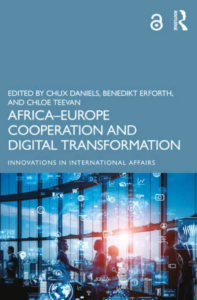Chux Daniels chaired the expert panel in charge of the Mutual Learning Exercise on setting up and implementing R&I policies and strategies, co-organised by the PSF service and the UN Interagency Task Team on Science, Technology and Innovation (STI) for the Sustainable Development Goals (UN IATT). He is a renowned specialist of STI policy and he recently published a book on Africa–Europe Cooperation and Digital Transformation. He also wrote a chapter on ‘Governance of Digital for Transformative Change in Africa’ in an upcoming peer-reviewed book titled African Governance in the Digital Age. He talks about how digitalisation should be handled in the elaboration of an R&I strategy or policy.
Why should digitalisation be carefully handled in the elaboration of an R&I strategy or policy?
Many R&I strategies and policies don’t deal with digital enough, or they do it in a piecemeal way (digital and R&D, AI, or big data, etc.), when it’s the entire digital ecosystem that needs to be governed properly, with the same core principles. But the most important thing, and this is an argument we are making, is that we need to have a balanced approach to digital. Let me explain. There is one pessimistic framing and approach to digital, which for example, dwells too much on the negative aspects of digital – ethical issues, privacy issues, security and risks and others. These negative concerns, which are important and should be, yes, taken seriously, note that we must take precautionary approach and principles to make sure that digital does not destroy the world. And there is another group of people who are optimists, saying that digital is going to solve every problem, everything. But it is very rare to see strong and robust arguments that are bringing the two together, saying there are risks and opportunities. And if so, how do we ensure a balanced approach?

I can give an example from Africa where we know what M-Pesa is doing, transforming the world, not just Kenya, by providing financial inclusion to people who have limited access to formal bank systems and infrastructure, because it costs money to travel to cities where bank branches are located. This example shows the potential for digital to foster inclusiveness, to grow economies, to create many jobs. But many are silent on the negative side of this business; in which, for example, some companies lend money to people without, in some cases, doing proper checks. This encourages people to get into debt. Therefore, we need a governance framework that deals with the two dimensions of digital – positive and negative aspects – properly. In the handbook we are elaborating on R&I strategies and policies, we have a chapter on governance, so that you can actually deal with issues of governance in a way that fosters innovation and digital economic growth, while addressing risks and understanding issues of security, privacy or ethics.

What are the issues to prioritise and the pitfalls to avoid?
If we use the sustainable development goals as a framework for prioritisation, we can see how digital contributes to economic, social and environmental components. Some countries also try to prioritise digitalisation in another way, looking at sectors or systems. Maybe we need to look at digital more in terms of energy systems or agriculture systems. Again, this brings in the importance of impact. Where will digital develop the highest impact? If we apply digital in agriculture, would it give us more impact than in transport, for example? All sectors are important, but most governments or actors can’t do everything at the same time, especially in resource-constraint countries. And if you look at digital, it may be more useful in agriculture in developing countries, for example, in Africa, where the agriculture sector employs more people and can reach maybe 10,000 people or 10 million people, create more jobs, improve productivity and boost economic growth. Another way of prioritising is to look at systems or sectors that can actually impact on other systems or sectors. For example, if we choose education, digitise the sector and empower education very strongly using digital, how much would it impact on other sectors? Which sectors will be covered? Likewise, if we digitise the energy and mobility systems, what other systems could we be strengthening at the same time? Food and agriculture systems, infrastructure, education, finance, industry? A lot! These are the kinds of dimensions to prioritise. And then when prioritising, you begin to think also about the pitfalls to avoid. If we talk about digital and education, what should we do? Who are going to be the winners and the losers? We must think about negative externalities, which are unintended consequences, and design appropriate and responsive policy instruments. Who are the people who will suffer from it? On the digital specific part, we know there are some countries where digital is being used to spy on citizens, to control dissent. So if we want to increase digital in education, and want children to have access to iPhones, computers and platforms, how do we secure their privacy, security and mitigate risks? Other pitfalls could be exclusion because we know that digital is also reinforcing biases and exclusion. People in rural areas or women can be further marginalised. So pitfalls are diverse, some are technological, some are social and some are economic. Again, this is why balanced framing and appropriate governance frameworks and systems are very important. As we introduce digital technologies to improve economic well-being, we also need to have robust governance systems that are based on clearly defined core principles. And in order to set up an efficient governance system, we need to involve many actors, academics, policymakers, industry, even people from the legal judiciary system (for the legal checks, balances and accountability system). Sadly, in many places, we do not have such governance frameworks in place. This is why we have a chapter on governance and on priorities as well in our handbook.
